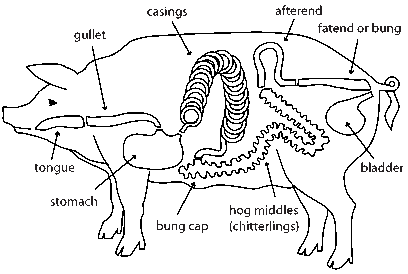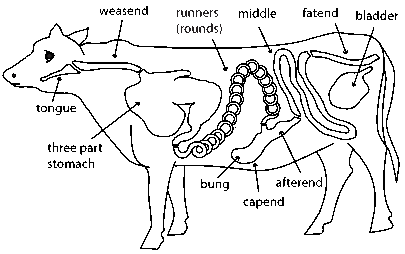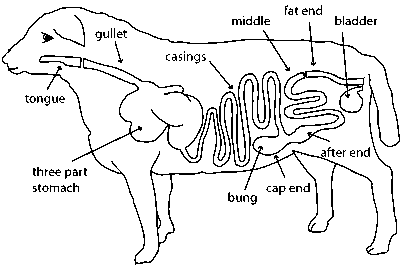Meats and Sausages
Sausage Casings
Casings can be divided into two groups:
- Natural casings.
- Synthetic casings.
It is impossible to match the quality of natural casings. They can be used for almost any product. The biggest advantage of using natural casings is that they shrink equally with the meat and thus are great for making dry or semi-dry salami or sausages. That leaves their use to smaller butchers or sausage makers, and it is the preferred choice for a home producer. Another advantage is that they are edible, and you don’t feel them when eating a well-made smoked sausage.<
The main reason that commercial manufacturers seldom use natural casings is the fact that they are not uniform, having different diameters, textures, and lengths. They also tend to produce a curved sausage, especially beef rounds. The meat plant cannot precisely estimate the weight of meat the casing will accommodate and cannot establish the correct price in advance. Simply put, it is impossible to run a business when no two samples are alike. Natural casings are usually packed and stored in salt. Before use, they should be rinsed on the outside and flushed out with water inside. Then, they should be left for 30 minutes in water-filled container. That removes more salt from the casings and makes them softer and easier to work with when stuffing. Natural casings are usually obtained from pigs, cattle, and sheep and can be generally classified as:
| Small intestine casings | Large intestine casings | Other |
|---|---|---|
| hog and sheep casings, beef rounds (runners). | hog and beef middles, bungs. | stomach, bladder. |
Hog Casings

| Casings | Middles | Bungs or fatends |
|---|---|---|
| 30-32 mm, frankfurter, breakfast sausage, Italian sausage. | 45 - 50 mm, Italian salami (frisses), blood sausage, sopressata. | 50 - 90 mm, Liver, Braunschweiger. |
| 32-35 mm, bratwurst, bockwurst, Italian sausage. | 50-60 mm, dry salami, liver sausage. | |
| 35-38 mm, knockwurst, Polish sausage, bratwurst, pepperoni. | 60-70 mm, cooked Braunschweiger. | |
| 38-44 mm, Polish sausage, summer sausage, ring bologna, liverwurst, pepperoni. |
Hog Casings are sold in “bundles” or “hanks.” This unit of measure equals approximately 91 meters. One bundle of 38 mm casing will accommodate about 132 lbs. (60 kg) of meat.
Beef Casings

| Rounds | Middles | Bung Caps |
|---|---|---|
| 35-46 mm, Ring Bologna, Ring Liver, Blood Sausage, Polish Sausage, Holsteiner. | 45-65 mm, Bologna, Dry and Semi-dry Cervelats, Dry and Cooked Salami. | 76-126 mm, Large Bologna, Lebanon Bologna, Cooked salami, Mortadella. |
Beef casings are tougher than hog casings and should be soaked in water longer. When making fermented sausages beef casings also have a higher tendency to become slimy during fermentation or the drying stage. This is a minor inconvenience as the slime is simply wiped off.
- Beef rounds - are the small intestines and derive their name from their characteristic “ring” or “round” shape.
- Beef middles - are the large and straight intestines.
- Beef bungs - are used for making large sausages like mortadella or large bologna.
- Beef bladders - are the largest casings and will hold up to 14 lbs. (6.5 kg) of sausage. They are used for mortadella, pepperoni and minced ham sausages.
Sheep Casings
Sheep casings are the highest quality small diameter casings used for sausages such as: Bockwurst, frankfurters, wieners, Polish Kabanosy and breakfast sausage links. These casings combine tenderness with sufficient strength to withstand the filling, cooking, and smoking operations. Their diameter varies from 18 - 28 mm.

For a hobbyist, natural casings are hard to beat. They are tender, they can be used for any sausage and will last almost indefinitely when salted and kept under refrigeration. Natural casings can be reused even if they have been soaked. Add regular table salt to the casings, place them in an air-tight container such as a zip-lock, and refrigerate. Don’t freeze as this will rupture their structure and weaken them.
Typical use for natural casings
Hog casings
- Small casings - fresh sausage, Bockwurst, Polish sausage, frankfurters, and chorizos.
- Hog middles - are the large intestines of a pig, also called chitterlings. They are used for making dry sausages.
- Hog bungs - are the colon of the pig. They are used for liver sausages and dry sausages such as Milano, g=Gothaer, and Salami Arles.
- Hog stomachs - head cheese.
- Hog bladders - luncheon meats.
Beef casings
- Round (small casing), middle, and bung (blind end).
- Bladders - luncheon meats and mortadella.
- Rounds - ring bologna, holsteiner, mettwurst.
- Middles - bologna, cervelat, blood sausage.
- Weasands (the lining of the esophagus or passage to the stomach) - long bologna and salami.
Sheep casings
- Casings - meat sticks, kabanosy, wieners.
Note that beef and sheep possess a three-chamber stomach, making it difficult to use. Pork stomach consists of one chamber with two entrances and has been traditionally used for making head cheeses. One opening would be sewn with butcher’s twine, the casing would be stuffed, and the second opening would be sewn off.
Synthetic Casings
Artificial casings are inedible and don’t require refrigeration. They can be made in a variety of colors and diameters. Clear casings can be used for liver sausage, red for bologna; some casings come pre-printed; for example, casings with deer antlers can be used for sausages made from wild game meat. Before use, cellulose casings and other artificial casings should be immersed for 30 minutes in water to facilitate stuffing. Synthetic casings are straight, consistent in diameter, require less preparation, and are easier to stuff. Those are good reasons why commercial manufacturers use them.
| Name | Description | Use |
|---|---|---|
| Collagen | 16-140 mm made from collagen, which is the main ingredient of connective tissue, skin and bones. The casings are made from beef hides. There are several types of collagen casings on the market today. There are edible casings for making fresh and smoked sausages. Can be used for smoked or dried sausages. | Edible: breakfast links, wieners, frankfurters, fresh sausages. Non-edible: ring-style sausages, salami, a good substitute for beef middles. |
| Cellulose | 15-44 mm strong, can be used for smoked or air-dried sausages. | Non-edible: skinless hotdogs and frankfurters. |
| Fibrous | 38-198 mm come in different colors and are popular among processors who don’t smoke sausages with natural wood but instead add liquid smoke. A mahogany-colored casing looks as if it were smoked. Casings exhibit excellent permeability for smoke penetration and moisture evaporation and can be used for smoked or dried sausages. | Non-edible: summer sausage, salami, pepperoni, bologna. |
| Plastic | 18-152 mm provide barriers to moisture, smoke, and oxygen to maximize shelf life and minimize off-flavors of prepared foods. They can be used for cooked products such as liver sausage, ham, or cooked salami. They can not be used for smoked or dried sausages. | Non-edible: Liver sausage, Mortadella, Cooked Salami. | name
| Hukki | 40-200 mm available in different net patterns for a traditional look of the products. Hukki is made of collagen (edible and not), cellulose, fibrous, or plastic casings. This name does not imply a new material but an unusual and decorative shape of the casing. | Non-edible (plastic): for cooked products. Edible: (fibrous) for smoked or dried products. |

















